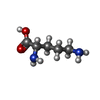+Search query
-Structure paper
| Title | Ornithine capture by a translating ribosome controls bacterial polyamine synthesis. |
|---|---|
| Journal, issue, pages | Nat Microbiol, Vol. 5, Issue 4, Page 554-561, Year 2020 |
| Publish date | Feb 24, 2020 |
 Authors Authors | Alba Herrero Del Valle / Britta Seip / Iñaki Cervera-Marzal / Guénaël Sacheau / A Carolin Seefeldt / C Axel Innis /    |
| PubMed Abstract | Polyamines are essential metabolites that play an important role in cell growth, stress adaptation and microbial virulence. To survive and multiply within a human host, pathogenic bacteria adjust the ...Polyamines are essential metabolites that play an important role in cell growth, stress adaptation and microbial virulence. To survive and multiply within a human host, pathogenic bacteria adjust the expression and activity of polyamine biosynthetic enzymes in response to different environmental stresses and metabolic cues. Here, we show that ornithine capture by the ribosome and the nascent peptide SpeFL controls polyamine synthesis in γ-proteobacteria by inducing the expression of the ornithine decarboxylase SpeF, via a mechanism involving ribosome stalling and transcription antitermination. In addition, we present the cryogenic electron microscopy structure of an Escherichia coli ribosome stalled during translation of speFL in the presence of ornithine. The structure shows how the ribosome and the SpeFL sensor domain form a highly selective binding pocket that accommodates a single ornithine molecule but excludes near-cognate ligands. Ornithine pre-associates with the ribosome and is then held in place by the sensor domain, leading to the compaction of the SpeFL effector domain and blocking the action of release factor 1. Thus, our study not only reveals basic strategies by which nascent peptides assist the ribosome in detecting a specific metabolite, but also provides a framework for assessing how ornithine promotes virulence in several human pathogens. |
 External links External links |  Nat Microbiol / Nat Microbiol /  PubMed:32094585 / PubMed:32094585 /  PubMed Central PubMed Central |
| Methods | EM (single particle) |
| Resolution | 2.7 Å |
| Structure data | EMDB-10453, PDB-6tbv: EMDB-10458, PDB-6tc3: |
| Chemicals |  ChemComp-MG:  ChemComp-K:  ChemComp-UNX:  ChemComp-ZN:  ChemComp-ORN:  ChemComp-HOH: |
| Source |
|
 Keywords Keywords | RIBOSOME / SpeFL / arrest peptide / ornithine / protein synthesis |
 Movie
Movie Controller
Controller Structure viewers
Structure viewers About Yorodumi Papers
About Yorodumi Papers








